Tarrant County Courthouse
Introduction
Text-to-speech Audio
Considered by many to be one of the "crown jewels" of downtown Fort Worth, the Tarrant County Courthouse was designed by the architecture firm of Frederick C. Gunn & Louis Curtiss. It was built between 1893-1895 at a cost of over four hundred thousand dollars, an expense that aroused concern among many residents and led the election of local candidates pledged to limiting public expenditures in the future. In the second half of the 20th century, a number of local officials hoped to modernize the interior and exterior of the courthouse, while others hoped to replace the building altogether. For many residents, however, the building's distinctive western flair and historical qualities were qualities that demanded its preservation.
Images
Daytime view of main entrance. The courthouse is widely-recognized for being featured in the television series: "Walker, Texas Ranger."
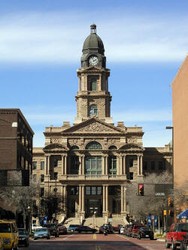
Restored West Portico
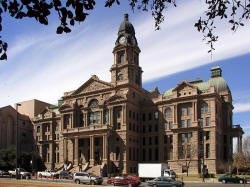
View from above.
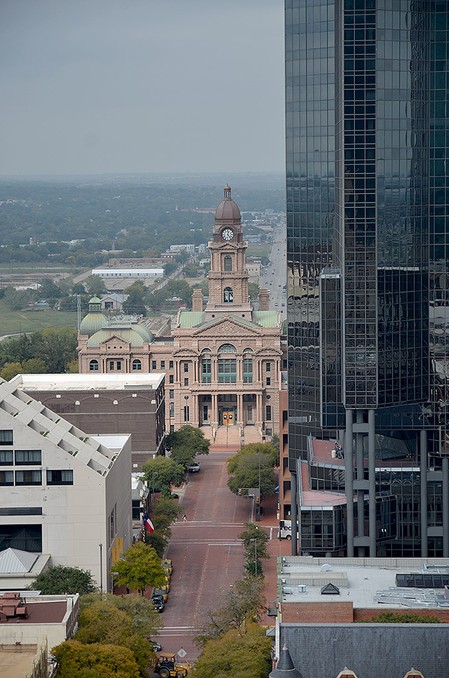
Photograph of Courthouse in 1922.
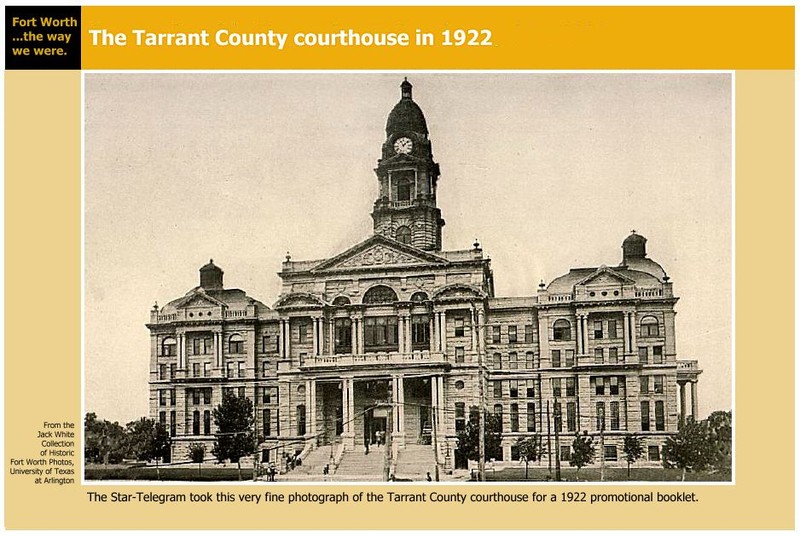
View of Courthouse during construction.
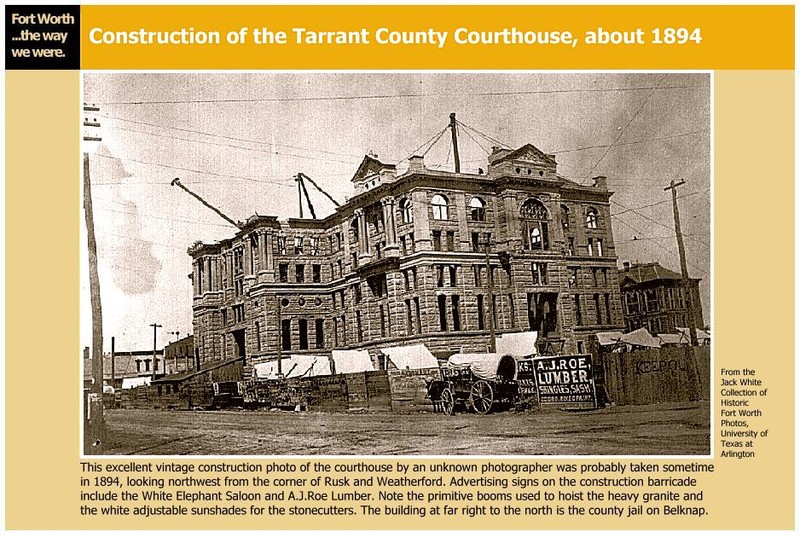
Backstory and Context
Text-to-speech Audio
The historic Tarrant County Courthouse sits among the modern glass towers of downtown Fort Worth, Texas. A Fort Worth landmark, the Courthouse is both historic, and functional. However, the Courthouse has not always looked so regal, nor has it been seen as useful.
Although admired for its beauty and historic charm, the costs associated with the construction of Tarrant County Courthouse aroused controversy at the time of its completion in the late 19th Century. The colossal building costs were considered such a public extravagance that a new County Commissioners' Court was elected in 1894, prior to the building's completion.1
The Courthouse was modeled after the Texas Capitol Building in Austin and uses the same rare Texas Pink Granite, a costly building material even today.2 It was one of the first public buildings to utilize a steel frame in the Southwestern United States-a trend that emerged (and largely stayed) in New York City. The first such building was the flatiron building--a triangular New York icon that also stands to this day.
Rising to a then-towering height of 191 feet, the once-commanding size of the courthouse was soon dwarfed by newly-constructed high-rise commercial towers as Fort Worth grew rapidly in the early 20th century. Although revered for its historical qualities, for several decades the leaders of the county attempted to "modernize" the interior of the building. For example, construction crews covered the central rotunda and even added a neon flag to the roof, just to name a few of many "improvements."
In 1958, the County Commissioners devised a plan to add a new Civil Courts building on the west side of the Courthouse.3 The old west portico was removed to make a connection between the two buildings. The new Civil Courts building was the part of a master plan to build a criminal courts building on the east side of the Courthouse. After both expansions were completed, the city attempted to demolish the grand 1895 Courthouse.
Local citizens came together to oppose the destruction of the historical courthouse, causing county officials to quickly reconsider the plan and preserve rather than replace the historic building. Nearly one-hundred years after initial construction, the Fort Worth City Council decided to restore the Courthouse to its former grandeur. Led by master architect Ward Bogard, the city restored the entirety of the Courthouse, excluding the clocktower. In 2012, architect Arthur Weinman led the restoration of the famous clocktower, finishing the decades long restoration of the famous building.
Finally, in 2014, the city demolished the Civil Courts Building, and restored the west portico, creating the beautiful courthouse that now graces the skyline of Fort Worth.
Although admired for its beauty and historic charm, the costs associated with the construction of Tarrant County Courthouse aroused controversy at the time of its completion in the late 19th Century. The colossal building costs were considered such a public extravagance that a new County Commissioners' Court was elected in 1894, prior to the building's completion.1
The Courthouse was modeled after the Texas Capitol Building in Austin and uses the same rare Texas Pink Granite, a costly building material even today.2 It was one of the first public buildings to utilize a steel frame in the Southwestern United States-a trend that emerged (and largely stayed) in New York City. The first such building was the flatiron building--a triangular New York icon that also stands to this day.
Rising to a then-towering height of 191 feet, the once-commanding size of the courthouse was soon dwarfed by newly-constructed high-rise commercial towers as Fort Worth grew rapidly in the early 20th century. Although revered for its historical qualities, for several decades the leaders of the county attempted to "modernize" the interior of the building. For example, construction crews covered the central rotunda and even added a neon flag to the roof, just to name a few of many "improvements."
In 1958, the County Commissioners devised a plan to add a new Civil Courts building on the west side of the Courthouse.3 The old west portico was removed to make a connection between the two buildings. The new Civil Courts building was the part of a master plan to build a criminal courts building on the east side of the Courthouse. After both expansions were completed, the city attempted to demolish the grand 1895 Courthouse.
Local citizens came together to oppose the destruction of the historical courthouse, causing county officials to quickly reconsider the plan and preserve rather than replace the historic building. Nearly one-hundred years after initial construction, the Fort Worth City Council decided to restore the Courthouse to its former grandeur. Led by master architect Ward Bogard, the city restored the entirety of the Courthouse, excluding the clocktower. In 2012, architect Arthur Weinman led the restoration of the famous clocktower, finishing the decades long restoration of the famous building.
Finally, in 2014, the city demolished the Civil Courts Building, and restored the west portico, creating the beautiful courthouse that now graces the skyline of Fort Worth.
Cite This Entry
Kunkel, Declan, Kyle Warmack, and Clio Admin. "Tarrant County Courthouse." Clio: Your Guide to History. March 12, 2018. Accessed April 22, 2025. https://theclio.com/entry/24591
Sources
1. Staff (2010-07-09). "National Register Information System". National Register of Historic Places. National Park Service.
2. "Tarrant County Courts." Tarrant County, Texas. Accessed July 24, 2016. http://access.tarrantcounty.com/en.html.
3. Roberts, John, AIA. "Tarrant County Courthouse." Architecture in Downtown Fort Worth. 2015. Accessed July 24, 2016. http://www.fortwortharchitecture.com/courthse.htm.

